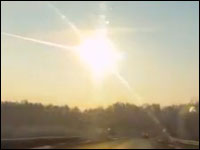
A blazing meteor streaked across the skies of Russia on Thursday, leaving a large smoke trail in its wake before blowing up over the remote town of Chelyabinsk in the Ural mountains. More than 1,000 people reported injuries, and windows across the region were shattered by a deafening sonic boom.

On Friday, a 150-foot-wide asteroid named 2012 DA14 whizzed by the Earth with just over 17,000 miles of separation to spare. That makes it the closest approach ever to the planet for a space rock of that size.
The two celestial events were not connected, NASA said; they approached the Earth from different trajectories. Yet they are just two of several meteors and asteroids that have come close to the Earth in the past few years.
There are between 3,200 and 4,700 potentially hazardous asteroids in our solar system, NASA estimated. This week’s sky shows, while fascinating to watch, have spurred discussions about whether the system for detecting potentially dangerous meteors and asteroids is adequate — and if not, what is being done about it.
More on the Chelyabinsk Meteor
The meteor that exploded over Chelyabinsk was the largest reported since 1908, when one hit Tunguska in Siberia. It entered the atmosphere at about 40,000 mph, or 18 km per second, NASA said, and released several hundred kilotons of energy.
The meteor measured about 49 feet and had a mass of about 7,000 tons. It was brighter than the sun, and its trail was visible for about 30 seconds. It had a very shallow angle of entry.
The meteor might have exploded because it was either big or dense enough that it didn’t burn up entirely in the atmosphere, but still experienced “immense aerodynamic pressures [that were] enough to structurally deform it,” said Ben Corbin, a Ph.D. candidate in aeronautics and astronautics at the Massachusetts Institute of Technology. “It’s simply a matter of how much energy is getting displaced at once.”
If the meteor had hit a densely populated area, it could have taken out an entire city, William Newman, professor of earth and space sciences at the University of California at Los Angeles, told TechNewsWorld.
Blind Man’s Bluff
The other big space rock to make the news, 2012 DA14, was discovered on February 23, 2012, and has been tracked closely since then. That raises the question of why the Chelyabinsk meteor seemed to have come out of nowhere.
One reason: The Chelyabinsk meteor was too small, being about 1.5 meters on a side, whereas 2012 DA14 “is about half the size of a football field,” Newman said. “It’s possible to see a railroad car heading towards us at a distance, but it’s impossible to see a baseball or bullet heading our way.”
Asteroids that cross the Earth’s orbit are only visible in daytime, so they’re harder to observe than those outside Earth’s orbit, Corbin told TechNewsWorld. They can be detected with radar, but that technology can only be used to find objects when they’re very close, because radar waves have to be bounced off the subject.
NASA maintains a database of asteroids that could impact the planet as part of its Near Earth Object program.
The program “is able to detect about 90 percent” of the larger asteroids that could impact Earth, and “we’re getting to the point where we’ll be able to detect almost all of those,” Newman said.
A Future Early Warning System?
The Chelyabinsk meteor shows the need to set up spacecraft circling the Earth to intercept and evaluate incoming threats, argued Rick Tumlinson, chairman of Deep Space Industries, which plans to mine asteroids for their precious metals.
The company is working on the FireFly spacecraft that would begin prospecting for potential target asteroids in 2015, and the larger Dragonfly spacecraft that would do the actual mining work.
Placing a circle of 10 Fireflies around the planet would cost about US$100 million and take about four years, Tumlinson estimated.
“We’re talking about space budgets,” Tumlinson told TechNewsWorld. “The idea is to send out the Fireflies to take close-up shots, then for the Dragonflies to come back with samples so they can be analyzed. By 2021, we can make contact with the asteroids and figure out which ones can be mined safely, and which will need to have their orbits shifted so they don’t threaten Earth.”
Setting up a planetary defense system would need to be done sooner, Tumlinson agreed, “but you have to start somewhere.”






















































Chelyabinsk wasn’t the only fireball reported on the same day that DA14 passed by. I don’t know if I believe Frank Davis that most of them actually were related to DA14 in some way, but he has a couple possible explanations for the different trajectories. And these are supported by his computer models. If there’s a chance that he’s right it means that near-miss asteroids can be accompanied by such events — meaning a serious risk when Apophis passes in 2029. If he’s wrong, I’d like to see NASA or someone specifically debunk his models.
https://cfrankdavis.wordpress.com/2013/07/07/rock-cloud-strike/
https://cfrankdavis.wordpress.com/2013/06/09/hunting-for-che/
https://cfrankdavis.wordpress.com/2013/09/14/a-different-health-risk/
http://tallbloke.wordpress.com/2013/03/05/andrew-cooper-were-the-recent-asteroid-flyby-and-russian-meteor-strike-events-linked/
— Jim Burrill